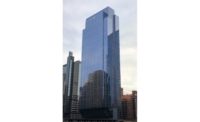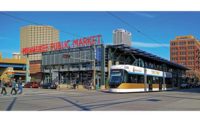The computer-aided design services Yousif Ghafari first offered Detroit-area architecture/engineering clients in the early 1980s seem rather primitive compared with the multidimensional modeling and visualization technology his company, Ghafari Associates, routinely uses today. Yet at the time, those manipulatable computer screen images represented the beginning of an industry-wide transformation, one in which expertise such as Ghafari’s would come to be highly valued.
Over the ensuing 30-plus years as Ghafari has expanded both its size and services, the firm has remained an early and eager adopter of new design technology, applying it to projects so complex that programming bugs unknown to the developer are revealed.
“We report the issues, but until they are resolved, we have to establish creative work-arounds to keep projects on schedule,” explains Kouhaila Hammer, Ghafari’s president and CEO since 2000. “Our ability to push software to the limits has created partnering relationships with several developers to help them better predict and prevent pre-launch glitches.”
Technological acumen isn’t the only attribute that has come to define Ghafari Associates. Now headquartered in Dearborn, Mich., and a fixture among ENR’s annual ranking of the Top 200 Design Firms, the 530-person company boasts a diverse, international portfolio of projects managed from 14 offices in the U.S. and overseas.
In 2016, Ghafari reported $94.2 million in Midwest revenue, up 20% from the previous year’s $78.5 million. Of the company’s overall $145.8 million in design revenue for 2016, more than a quarter came from projects outside the U.S.
Hammer credits the business uptick to overall economic improvement, plus repeat business from clients.
“A lot of projects delayed by the recession are out there now,” she explains. “There’s a lot of catching up to do, especially in manufacturing and domestic aviation.”
One example is key client General Motors’ aggressive program to renovate and upgrade its North American production facilities for its next-generation truck and SUV lines. Ghafari has provided full architecture, engineering and construction administration services for more than 4.4 million sq ft of manufacturing facilities in Michigan, Indiana, Texas and Mexico.
As those projects move forward, Ghafari is also helping facilitate another transformation—the evolution of building design from the way baby boomers made and managed things into venues tailored to their tech-savvy, image- and idea-sharing millennial children and grandchildren.
“That means bright, sustainable facilities,” Hammer says. “No hard walls, more open spaces for collaboration—totally different from the dingy plant image of manufacturing.”
At the new Fort Collins, Colo., campus of Woodward, the world’s oldest and largest independent designer, manufacturer and service provider of energy control systems for the aerospace and industrial sectors, Ghafari organized a new 300,000-sq-ft industrial turbo-machinery systems building around a multi-level “Main Street” corridor that serves as the spine of the 100-acre campus. The building includes both manufacturing spaces and offices, connected by two structurally suspended staircases.
Nearby, a new 60,000-sq-ft headquarters building visually anchors the campus on the east and conveniently links back to its engineering and manufacturing components. Both projects are part of Woodward’s $200-million campus development program, master planned by Ghafari, which will eventually house 1,700 workers.
Closer to home, the Ghafari-designed 35,000-sq-ft Toyota Industrial Equipment Manufacturing (TIEM) T+Rex Recreational Complex in Columbus, Ind., offers a wide variety of fitness and wellness amenities for employees and their families, including primary health care, physical therapy and a full-time pharmacy.
Tim Hollkamp, TIEM project manager for facilities and engineering, says the Ghafari team approached the project eager to grasp his organization’s culture while also expediting a project that was ultimately opened just 11 months after contract signing.
The Ghafari team has what has been referred to in the past as the “Midwest work ethic,” Hollkamp explains. “They rolled up their sleeves and got to it. They dedicated the resources to see that decisions were made quickly but thoroughly.”
Hollkamp adds that Ghafari never came to design reviews with only one option for Toyota’s requests.
“They were always prepared and honest about their capabilities,” he says. “It showed they cared.”
Keeping Pace With Personnel
Ghafari can well empathize with the programming priorities of its clients’ projects. As with most other design and construction enterprises, it too must compete for technically talented professionals who will bring ideas and insights to those designs. In addition, the firm is coping with the intricacies of seamlessly transferring knowledge between its more experienced staff members who may be eying retirement and those at the outset of their careers.
“The economy drop cost us an entire generation of technical knowledge,” says Scott Adams, the firm’s manager of technology practice. “They didn’t have the opportunity to go to school, so they didn’t learn how buildings are built.”
To help bridge those gaps, Ghafari has stepped up its training, including establishing an online, multidisciplinary “Ghafari University” development program, which provides brief, video-based discussions of best practices on a variety of topics. Partnerships among senior and junior employees also help facilitate a better understanding of the design business’ “soft skills,” which are essential to relationships with contractors and clients.
Ghafari’s innovative bent has likewise facilitated the adoption other industry trends. In the early 2000s, the GM Lansing Delta Township Assembly Complex offered an opportunity for utilizing collaborative principles that would become the foundation of integrated project delivery, resulting in substantial cost and time savings.
For another Woodward project—a $110-million, 440,000-sq-ft manufacturing facility at the company’s Rock Cut campus in Loves Park, Ill., Ghafari and contractor Ringland-Johnson Construction, Cherry Valley, Ill., pooled their expertise and technology resources to tackle the owner’s demand for a facility built around demanding aerospace manufacturing processes.
“Ghafari’s ability to adapt to Woodward’s culture made them the perfect partner for this ‘inside-out’ approach,” says Brent Johnson, Ringland-Johnson president and CEO. “We were able to achieve a zero-error rate in construction, which saved millions of dollars in costs and got the job finished two months early.”
Ghafari has adopted other similar productivity-enhancing processes such as the use of prefabricated building elements, which Adams says are used as often as possible. Two Ghafari-designed Ford production facilities in Mexico, for example, made extensive use of prefabricated toilet facilities.
“We see prefabrication as the next generation of the industry,” Adams said, admitting that the integration and planning involved requires experts to provide their input earlier in the design. “It’s almost like a separate project within a project, and more contractors are starting to grasp the concept.”
Ghafari has also applied its technical expertise to help project teams adapt to lean construction practices by developing vPlanner, a visual planning and control software product that supports lean project delivery using the Last Planner® System (LPS). The company claims that “dozens of AEs/contractors/owners/and subcontractors have used vPlanner over the past several years with a project value over $8 billion.”
Along with providing users with a comprehensive project management tool, Adams says vPlanner is also designed to help newcomers familiarize themselves with the lean approach.
“The tool puts lean principles in a more understandable format, making it easier to manage projects, especially those located overseas,” he said.
High Community Profile
Ghafari has sought to match its contributions to the industry with maintaining a high community profile. That example was set by Yousif Ghafari himself as he stepped away from the firm in 2008-09 to serve as U.S. Ambassador to Slovenia. Now the company’s chairman, he is actively engaged in the community and industry, serving on the boards of the Detroit Economic Club and the Wayne State University (WSU) Foundation as well as the board of visitors for WSU’s College of Engineering.
As a firm, Ghafari Associates works with a variety of charities that address hunger, while its Chicago office is actively involved in the city’s ACE mentorship program. Ghafari has also extended its internship program, providing additional opportunities for students to gain experience and, potentially, become full-time employees themselves.
And the sooner those aspiring professionals can join Ghafari, the better. “Overall, we feel the market will remain strong well through 2018, with a slight tapering off of industrial work in the next few years,” Hammer says. Balanced by the need for infrastructure investment and a projected moderate increase in health care opportunities, “we’ll continue to invest in expanding in domestic as well as international operations to leverage our position in those economies.”







Post a comment to this article
Report Abusive Comment